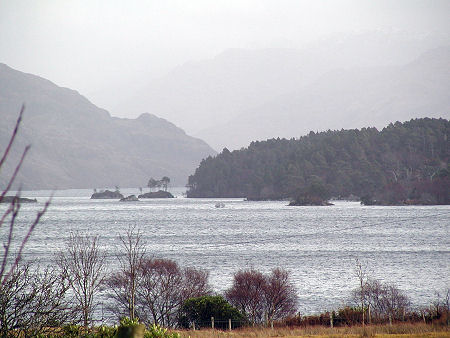 The Islands on Loch Morar, where Simon Fraser was Captured |
Simon Fraser, 11th Lord Lovat, lived from about 1667 to 9 April 1747. Known as "the Fox" and "the most devious man in Scotland", he became Chief of Clan Fraser and was a sometime Jacobite sympathiser. The wider picture in Scotland at the time is set out in our Historical Timeline.
Simon Fraser was the second son of Thomas Fraser, and the grandson of the 7th Lord Lovat. The main Clan Fraser seat was at Lovat Castle, on the banks of the River Beauly about a mile east of Beauly. Simon Fraser was born and raised at nearby Castle Dounie, a short distance south of Beauly, which remained his family home throughout his life. Castle Dounie was destroyed by the Duke of Cumberland following the Battle of Culloden and rebuilt in 1880 as a mansion known as Beaufort Castle.
Even as a very young man Simon Fraser's interests seem to have revolved around building a power base within Clan Fraser that would serve his personal ambitions. In 1699 he secured for himself the title of 11th Lord Lovat and the position of the Chief of Clan Fraser by the brutal expedient of a forced marriage with Amelia, Lady Lovat. She was the recent widow of the late 10th Lord Lovat, who had been a distant relative of Fraser's. This successfully gained him the title and estates, but so enraged Lady Amelia's family, including the powerful Duke of Atholl, that Fraser was forced to flee the country. He subsequently lost both the title and the Fraser family estates when his marriage to Amelia was annulled.
In France, Simon Lovat converted to Catholicism and attached himself to the Jacobite court-in-exile. In 1703 he returned to Scotland to sound out clan chiefs about a possible Jacobite uprising. It became obvious that there was little support to be found, so Fraser revealed the plot to the Government of Queen Anne in an effort to gain credit for himself, and falsely implicate the Duke of Atholl. Foolishly returning to France, Fraser was imprisoned there until able to escape in 1714.
During the 1715 Jacobite uprising, Lovat remained on the sidelines, writing to both sides to see which might offer him most advantage. In the event he obtained a pardon for his past crimes from the Government, and later benefitted by acquiring estates which had been forfeited to the Crown by Jacobites involved in the uprising. Meanwhile he continued to pursue a series of legal cases intended to regain the Lovat title and the estates that went with it. He finally succeeded in 1733, becoming 11th Lord Lovat once more.
During the 1745 Jacobite Uprising, Simon Fraser again tried to back both horses. He professed his support to the Jacobites but claimed his age prevented his personal participation (in fairness, he was by now in his late 70s). Instead he sent his son and a force of his Frasers to help the Jacobite cause. He then wrote to the Government claiming that he supported them and that his son's actions were against his wishes. The Government, this time at least, were not deceived, and after the final Jacobite defeat at the Battle of Culloden, the aged Fraser was forced to flee for his life. He was eventually captured hiding in a hollow tree on an island in Loch Morar, near Mallaig. He was taken to London, where he was put on trial. He became the last person to be executed by beheading in Britain on 9 April 1747, apparently being afforded some small final amusement when a stand erected for spectators collapsed, killing some 20 people. So ended the life of one of the least appealing characters to emerge from Scottish history.

